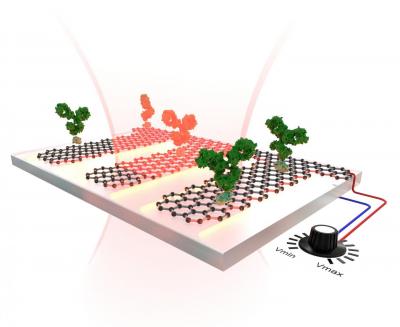Researchers at EPFL's Bionanophotonic Systems Laboratory (BIOS) together with researchers from the Institute of Photonic Sciences (ICFO, Spain) have harnessed graphene's unique optical and electronic properties to develop a reconfigurable and highly sensitive sensor that detects molecules like proteins and drugs.

The researchers used graphene to improve on a well-known molecule-detection method: infrared absorption spectroscopy. In that method, light is used to excite the molecules, which vibrate differently depending on their nature. The specific vibration means the molecules reveal their presence and even their identity. This "signature" can be "read" in the reflected light. This, however, is not an efficient method for the detection of nanomolecules. The wavelength of the infrared photon directed at a molecule is around 6 microns (6,000 nanometres - 0.006 millimeters), while the target measures only a few nanometres (about 0.000001 mm).
Using graphene, it is possible to focus light on a precise spot and spot the vibration of an attached nanometric molecule. In this study, researchers first pattern nanostructures on the graphene surface by bombarding it with electron beams and etching it with oxygen ions. When the light hits, the electrons in the graphene nanostructures begin to oscillate. This phenomenon concentrates light into tiny spots, which are comparable with the dimensions of the target molecules. It is then possible to detect nanometric compounds in proximity to the surface.
In addition to identifying the presence of nanometric molecules, this process can also reveal the nature of the bonds connecting the atoms that make up the molecule. Graphene is able to identify a whole range of frequencies, so researchers "tuned" the graphene to different frequencies by applying voltage, which is not possible with current sensors. Making graphene's electrons oscillate in different ways makes it possible to "read" all the vibrations of the molecule on its surface.
The scientists claim that this simple method proves that it is possible to conduct a complex analysis using only one device, while it normally requires many different ones. It also stresses graphene's incredible potential in the area of sensing. This concept can be used in different application fields, ranging from gas leakage, toxic and explosive gas sensing, and contaminants in water to DNA and proteins. This is because graphene is an inert material for the elements to be detected and the reading mechanism uses light which is free of any interference effect.

